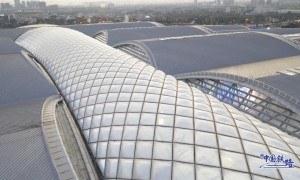原标题《Manufacturing and Assembling Buildings as 3D Monolithic Shearwall Modules》
《三维整体剪力墙模块的制造和组装》
作者:S. J. Vijay
注:
这篇文章内容没有我想要的信息,不过大概能了解一下目前印度的装配式建筑发展概况,还可以知道一些印度保障房方面的政策信息,仅此而已……印度是个善于开挂的民族,各种工法工艺满天飞。
翻译为机器翻译,大概明白意思就行了~我只是随手把自己浏览时机器翻译的内容和原文随手复制一下而已,这是第一次见到三哥的论文,猎个奇……
Abstract
摘要
Built spaces are transitioningfrom being static and dumb to becoming dynamic, responsive, intelligentfunctional systems for live, work, production, storage and retail. Thistransformation driven by the demands of the urbanizing world and enabled by abouquet of technologies are increasing the extent of manufacturing in makingthe building.
建筑空间正从静态和哑化转变为生活、工作、生产、存储和零售的动态、响应性、智能化的功能系统。这种转变是由城市化世界的需求驱动的,是由一系列技术推动的,正在增加建筑制造的程度。
Infusion of intelligence into the designand engineering activities of construction as AutoCAD, CAE has spread and nowstraddles the full activity-chain of construction. Singapore is the most successfulcountry to avail segmental manufacturing of buildings for over 40 years.
与AutoCAD一样,CAE已经扩展并跨越了整个施工活动链。新加坡是40多年来在建筑细分制造方面最成功的国家。
Monolithic Shearwall Module technologyeliminates numerous joints, connections – the root cause of leakages andseepages and all other problems in buildings made by assembling multipleelements to create one volumetric space. Bangalore-based hoMMission India applied this technique to Indianmarket requirements and cost expectations. A 5-storey building with20-apartments was manufactured and installed in 33 days in Mumbai. The 3D MonolithicShear Wall Modular manufacturing and assembly of all types of buildings,promises to be a potential game changer.
整体剪力墙模块技术消除了大量的接缝和连接,这是通过组合多个元素来创建一个体积空间而造成建筑物渗漏和渗漏以及其他所有问题的根本原因。总部位于班加罗尔的hoMMission India将该技术应用于印度市场需求和成本预期。在孟买,一栋有20套公寓的5层大楼只用了33天就建成并安装完毕。3D整体剪力墙模块化制造和组装所有类型的建筑,有望成为一个潜在的游戏规则改变者。
Keywords: Shearwall monolithic modules,Precast construction technology, Building manufacturing, Transformationaltechnology for construction industry
关键词:剪力墙整体模块、预制施工技术、建筑制造、建筑业改造技术
I. INTRODUCTION
1、简介
BUILDING a building is not a craft anymore.Manufacturing them as Building Materials and Building Products to form and finishthem into buildings with manual labour also appears to be ending. The “labour” and “skill” appearto be rushing into the list of endangered species. The pace, quantum andquality of construction demanded by the surging urbanization across the worldis pushing construction to a long overdue, now inevitable tipping point.“Stopbuilding – start Manufacturing and Assembly of Buildings as the first choice”is the new Mantra / Moto.
建筑不再是一门手艺了。制造它们作为建筑材料和建筑产品,以形成和完成它们的建筑与体力劳动似乎也将结束。这种劳动和技能似乎正迅速被列入濒危物种名单。世界各地飞速发展的城市化所要求的建设速度、数量和质量,正将建设推向一个姗姗来迟、如今不可避免的转折点。停止建造,开始制造和组装建筑作为第一选择是新的咒语/ Moto。
Hence, the staid and steady incrementallyevolving construction is transforming. Imperceptible to the unseeing butobvious to the ardent practitioners of design, engineering, construction,finishing,and building management are developments impacting each stage of making abuilding.
因此,这个一成不变、稳步渐进的建筑正在发生转变。对于热心的设计、工程、施工、装修和建筑管理的从业者来说,无形而又显而易见的发展影响着建筑制作的每个阶段。
Functionality is finally dictating theform. Aesthetics now must ensue from the Form serving Functionality.
功能最终决定了表单。现在,美学必须从服务功能的形式开始。
Also, efficiency is chosen over expanse ofspace. A room soon may have many roles. Bedroom in the night, office during theday that serves as the living room or party room during non-working hours. Theexpensive micro-apartments of New York are now multi-tasking its minisculespace thanks to the movable internal walls and foldable, motorized, modular,multi-task able furniture.
此外,效率是选择在广阔的空间。一个房间很快就会有很多角色。晚上是卧室,白天是办公室,非工作时间是客厅或聚会室。由于可移动的内墙和可折叠的、机动的、模块化的、可多任务的家具,纽约昂贵的微型公寓现在可以多任务了。
Multi-tasking the space to meet the need ofthe time of the day/night with the design and technology invention of MIT,Boston and made in China are already in action in New York, Tokyo in Japan,Mumbai in India. These and many tier 1 cities with the most expensivereal-estate are breeding this phenomenon of demanding efficiency over expanse.
麻省理工学院、波士顿和中国制造的设计和技术发明已经在纽约、日本东京、印度孟买发挥作用,满足了白天/晚上的时间需求。这些城市和许多拥有最昂贵房地产的一线城市正在滋生这种效率高于面积的现象。
Functionality as heightened functionality isdictating form and is replacing expensive expanse with efficient,multi-taskable space. Infusion of intelligence into the design and engineering activitiesof construction as AutoCAD, CAE has spread and now straddles the fullactivity-chain of construction. With BIM,it has now gone beyond constructionand onto operation and management of the building too.
功能作为增强的功能决定了形式,正在用高效、多任务的空间取代昂贵的空间。与AutoCAD一样,CAE已经广泛应用于建筑的设计和工程活动中,现在已经跨越了整个施工活动链。有了BIM,它已经超越了建筑,也进入了建筑的运营和管理。
This infusion of Intelligence is turning thestatic shells of the building into a functional, responsive “live-in systems”.
这种智能的注入正在把建筑物的静态外壳变成一个功能性的、响应性强的“生活系统”。
Smart Homes, Smart Cities are here now – amission of the Government of India indeed.
智能家居,智能城市现在就在这里——这是印度政府的使命。
The functionality, performance,convenience, responsiveness,strength and stability of the manufactured productslike the automobile, aircraft, cruise ships are now coming home or coming to homes that hitherto were dumbcore and shell.
汽车、飞机、游轮等制造产品的功能、性能、方便性、响应性、强度和稳定性现在正在回到家,或回到以前一直是哑巴和壳牌的家庭。
All built spaces are transitioning frombeing static and dumb to becoming dynamic, responsive, intelligent functional systemsfor live, work, production, storage and retail. This transformation driven by the demands of theurbanizing world and enabled by a bouquet of technologies are increasing the extentof manufacturing in making the building.
所有的建筑空间都从静态和哑化转变为动态的、响应性强的、智能化的功能系统,用于生活、工作、生产、存储和零售。这种转变是由城市化世界的需求驱动的,并由一系列技术推动,正在增加建筑制造的程度。
The pre-fabrication and pre-casting ofbuildings is increasing as substitutes for labour intensive sequential steps inbuilding a building. Batching of materials into RMC followed bunching ofactivities via Cast-in-Situ into manually arranged form works is now movinginto mechanized casting equipment placed in a factory setting. The Precastplants have sprung up in Northern,Central, Western and Southern India.
建筑物的预制和预铸正在增加,作为建造建筑物的劳动密集型顺序步骤的替代品。将材料分批注入RMC,然后通过现场浇注,手工安排模板,现在将进入工厂设置的机械化铸造设备中。预制工厂在印度北部、中部、西部和南部如雨后春笋般涌现。
These plants in India manufacture thebuildings as various structural elements of building such as wall panels, solidor hollow core slabs which are later assembled at site to form a monolithic structure [1].
这些位于印度的工厂生产各种建筑结构元素,如墙板、实心或空心板,然后在现场组装成一个整体结构。
The National Building Code of India and theBureau of Indian Standards have developed and published the first set of codes andstandards for this segmental manufacturing and assembly of buildings.
印度国家建筑规范和印度标准局已经为这种分段制造和组装的建筑制定并发布了第一套规范和标准。
The Building material and TechnologyPromotion Council of India under MOHUA of Government of India, is promoting themanufactured RCC Buildings and also assisting the alternate building materials ranging fromBamboo, Reinforced Thermocol, Light gauge steel framed structures etc.
在印度政府MOHUA的领导下,印度建筑材料和技术促进委员会正在推广人造碾压混凝土建筑,并协助替代建筑材料,包括竹子、增强热熔胶、轻钢框架结构等。
Towards mainstreaming the manufacturing ofbuildings, CPWD has released the Schedule of Rates enabling the Government toavail this newer, stronger, better manufactured building to meet their needs.
为了使建筑制造业成为主流,CPWD已经发布了让政府能够利用这一更新、更强、更好的制造建筑来满足他们的需求的比率时间表。
Impressive as it may seem, this movement ofManufacturing the different types of buildings for India, lags possibly, by a generation.
Post-world war, Europe adopted theManufacturing of Buildings as elements, panels, segments of slabs etc.Singapore is the most successful country to avail segmental manufacturing ofbuildings for over 40 years to abode all its citizens. Other continents such as USA, Australia etc. have all moved to the next level of manufacturing of buildings.
令人印象深刻的是,这种为印度制造不同类型建筑的运动可能滞后了一代人。
第二次世界大战后,欧洲采用了建筑制造作为构件、面板、分段板等。新加坡是最成功的利用建筑分段制造的国家,超过40年的时间,以居住所有的公民。其他大陆,如美国、澳大利亚等,都已经进入了建筑制造的下一个阶段。
They now manufacture the buildings as shearwall modules cast in one single pour replacing the multiple structuralelements,multiple wall panels, and slab pieces too. This Monolithic Module also eliminates numerous joints,connections – the root cause of leakages and seepages and all other problems inbuildings made by assembling multiple elements to create one volumetric space.
他们现在制造的建筑作为剪力墙模块浇铸在一个单一的浇筑,取代了多个结构元素,多个墙板,以及平板件。这个整体模块还消除了大量的接头、连接——这是通过组合多个元素来创建一个体积空间而造成的建筑物渗漏和渗漏以及其他所有问题的根源。
The 3D Monolithic shear wall modulesmanufactured by just one pour besides eliminating the problems arising out of multiplejoints amongst many elements also bunches the multiple manufacturing activitiesinto one step. The consequent savings in effort, time, equipment, space andmanpower enables the increase in productivity by orders of magnitude.
3D整体剪力墙模块由一个浇注制造,除了消除了许多元素之间的多个接头产生的问题,还将多个制造活动捆绑到一个步骤。由此而来的精力、时间、设备、空间和人力的节约,使生产率提高了数量级。
There are many other benefits inherent tothis advanced building manufacturing system. The handling stress of segmentalor 2D elements is more and demands more steel and other material in addition tothe normal quantities needed for the building. The modules have a much lesser handlingstress and do not consume additional steel. Also, all the service conduits forelectrical,plumbing, extra low voltage cables including the wall boxes can becast-in — needing no tedious interconnections that are time and effortintensive in segmental / 2D construction.
这种先进的建筑制造系统还有许多其他固有的好处。segmental2d元素的处理应力是更多的,需要更多的钢和其他材料,除了正常数量所需的建筑。该模块有一个更小的处理应力,不消耗额外的钢。此外,包括墙盒在内的所有电力、管道、特低压电缆的服务管道都可以浇筑,不需要繁琐的互连,这在分段/ 2D建筑中需要大量的时间和精力。
The remote-control operated 3D Mouldsmanufacturing the monolithic shear wall modules are made of high tensile seamlesssteel plates and also have built-in vibrators and curing facility. Hence, themodules attain strength of 12-14 MPA in 12 hours and come out with a Class A,Fair face finish on both sides needing no grinding or plastering and are readyto paint.
制造整体剪力墙模块的远程控制3D模具是由高强度无缝钢板制成的,也有内置的振动器和固化设施。因此,该模块在12小时内达到12- 14mpa的强度,并具有a级的表面光洁度,无需打磨或抹灰,可用于油漆。
Such manufacturing of buildings as 3D ShearWall modules is known by varying names across continents and their countries. Singaporecalls it Precast / (Prefabricated),Prefinished Volumetric Construction (PPVC).It has made this manufacturing technology mandatory for all buildings built onthe land of Government of Singapore. The manufacturing of these modules is done in Malaysia andassembled into fully finished unit before they are transported on trailer for installationin Singapore.
像3D剪力墙模块这样的建筑制造在不同的大洲和国家都有不同的名称。新加坡召回了预制/(预制),预制体积建筑(PPVC)。它已经将这种制造技术强制应用于所有在新加坡政府土地上建造的建筑物。这些模块的制造在马来西亚完成,然后组装成完整的单元,然后用拖车运输到新加坡安装。
The Building and Construction Authority(BCA) of Government of Singapore engaged many multinational Design, Engineeringand Building Manufacturing firms over the past years to operationalize this most advancedmanufacturing of buildings as shear wall modules.
新加坡政府建筑和建筑管理局(BCA)在过去几年里聘请了许多跨国设计、工程和建筑制造公司来运作这种最先进的建筑剪力墙模块制造。
BCA now runs a course in “Design forManufacturing and Assembly of Buildings (DfMA). It targets to train 16,000 professionalsannually for the next 5 years.
BCA现在开设了一门“建筑制造与组装设计(DfMA)”课程。它的目标是在未来5年里每年培训1.6万名专业人员。
Global construction industry, thus, isembracing manufacturing as the new norm to deliver better, stronger, functionaland intelligent buildings as live-in systems are increasingly demanded by bothpeople and the activities.
因此,随着居住系统日益受到人们和建筑活动的需求,全球建筑业正将制造业作为提供更好、更强、功能更强和智能建筑的新规范。
The Government of UK is engaging its fameduniversities and firms specialized in designing for manufacture and assembly.
It is promoting modular manufacture ofbuildings to solve the falling productivity of its construction industry.
英国政府公司聘请其著名大学和公司专门设计制造和组装。
它正在推动建筑模块化制造,以解决其建筑业生产率下降的问题。
The engineering code for modularmanufactured buildings has been arrived at by a large Australian consortium ofuniversities,practicing engineers and construction industry. This effort of codifyingthe engineering standards is led by the University of Monash in Australia.
模块化建筑的工程规范已经由澳大利亚大学、执业工程师和建筑行业组成的大型联盟制定。这项工程标准的编纂工作是由澳大利亚莫纳什大学领导的。
A small team in India, started in 2011,searched the global markets for the most advanced system for manufacturing of buildingsin India. After obtaining a comparative study of then available nine buildingmanufacturing systems offered by about 58 global companies, the Indian teamchose and adopted the 3D Monolithic shear wall Modular Manufacturing technology from Australia. Over the years this small Indian team, now called hoMMissionIndia has applied this to Indian market requirements and cost expectations. A5-storey building with 20-apartments was manufactured and installed in 33 daysby this small Indian team.
2011年,印度的一个小团队开始在全球市场上寻找最先进的印度建筑制造系统。在对当时全球58家公司提供的9种建筑制造系统进行比较研究后,印度团队选择并采用了澳大利亚的3D整体剪力墙模块化制造技术。多年来,这个现在被称为hoMMissionIndia的印度小团队已经将其应用于印度的市场需求和成本预期。一座有20间公寓的5层建筑由这个印度小团队在33天内建造和安装。
Post two-month long testing by Singaporeanand Indian entities,the Client Tata Housing awarded the Virtual Completion and AcceptanceCertificate. This building manufactured onsite as 3D Monolithic Shear Wallmodules has stood exposed to the forces of nature including 3 Intense Mumbaimonsoon rains even without plaster.
经过新加坡和印度实体两个月的测试后,客户Tata Housing获得了虚拟竣工和验收证书。该建筑现场制作的3D整体剪力墙模块暴露在自然的力量,包括三场强烈的孟买季风降雨,甚至没有石膏。
Standardization and consequentcomponentization are the key imperatives for any activity to be entering thedomain of manufacturing. Finding standardisable components for construction ofbuildings may drown us in the myriad codal provisions of National Buildingcode, the differing and evolving standards of Bureau of Indian Standards (BIS).The near anarchic prescriptions of DevelopmentControl Regulations of the Metropolitan Planning Authorities, Directorate of Townand Country Planning Authority etc are another quagmire. hoMMission over theyears discovered the inputs for standardization to Manufacture Buildings areactually in the uncodified standards and dimensions arrived at and applied by the construction industry in response tothe geographical,demographical demands as well as the type of real estate as residentialor commercial etc.
标准化和相应的组件化是进入制造领域的任何活动的关键要求。寻找建筑施工的标准失效部件可能会使我们淹没在国家建筑规范的无数法典条款中,印度标准局(BIS)的不同和不断发展的标准。城市规划当局、城乡规划管理局等部门制定的近乎无法无天的发展控制条例是另一个困境。hoMMission多年来发现,建筑制造的标准化投入实际上是建筑行业根据地理、人口需求以及住宅或商业等房地产类型所达成和应用的未编码标准和尺寸。
The first key input for standardization andcomponentization for modularized manufacturing of buildings was glaringly obviousin the column grid dimensions spans and floor heights across the typologies of residential,commercial, industrial,logistical and retail buildings. This was the bedrockfor the standardization that can lead to modularization and consequent modular manufacturing of buildings.
建筑模块化制造的标准化和组件化的第一个关键输入是非常明显的,横跨住宅、商业、工业、物流和零售建筑类型的柱网格尺寸、跨度和楼层高度。这是标准化的基石,可以导致模块化和随之模块化的建筑制造。
The four corners of the 3D shear wallmodules, once aligned to this grid and its dimension, the module as a wholewith all the walls or as a stool without the walls can be designed andmanufactured. When this module has built in provisions it turns into one of theinterconnectible structural elements.
三维剪力墙模块的四角,一旦与网格及其尺寸对齐,模块作为一个整体与所有的墙壁或作为一个凳子,没有墙壁,可以设计和制造。当这个模块内置了条款,它就变成了一个互连的结构元素。
As is obvious, the multiple structuralelements like columns plus beams and the slab with walls are bunched into oneand is also manufactured in one pour. Thus, this consolidated structural systemof a shear wall module is the new level of structural system that can bemanufactured at one go. Hence,this becomes the most advanced system ofmanufacturing a building, given its ease and pace of completion.
显而易见,像柱加梁和带墙的板这样的多个结构元素被捆绑在一起,也在一次浇筑中制造。因此,这种加固结构体系的剪力墙模块是一个新的层次的结构体系,可以一次制造。因此,这成为最先进的建筑制造系统,考虑到它的轻松和完成速度。
As these shear wall modules are Monolithicand made with time tested and proven building materials like concrete andsteel,the compliance to the myriad codes and standards is automatic.
由于这些剪力墙模块是整体的,并由经过时间测试和验证的建筑材料,如混凝土和钢,符合无数的规范和标准是自动的。
Except for the codes and standards for theconnections which are least in number in this advanced systemof manufacturing ofbuildings. However, International codes are available for the connectionsbetween the modules as well as with other elements of a manufactured andassembled building. The codes for Manufacturing and assembly of high rises indifferent seismic zones are also coming into place. (AIT, Monash University,PCI).
除了在这个先进的建筑制造系统中数量最少的连接件的规范和标准。然而,模块之间的连接以及与制造和组装的建筑的其他元素之间的连接都有国际规范。不同地震带的高层建筑的制造和装配规范也在制定之中。(河中的小岛,莫纳什大学,PCI)。
The standardization of just the narrowerside of the column grid is sufficient to design and fabricate the 3D Moulds,the magical core of Modular Manufacturing of Buildings. The same mould candeliver modules with different lengths, different wall thicknesses, differentheights and openings of different sizes wherever required, the only fixeddimension is the narrow side of the column grid for fixing the width ofthe mould which is taken from the standardization. Any project of sufficiently largesize demands manufacturing from a set of 3D Moulds to ensure delivery in agiven time frame. Hence, a set of moulds with a range of widths can break thisconstraint and make 3D Shearwall construction a completely flexible one.
仅仅是较窄的柱状网格的标准化就足以设计和制作3D模具,这是建筑模块化制造的神奇核心。同一模具可根据需要提供不同长度、不同壁厚、不同高度和不同尺寸开孔的模具模组,唯一固定尺寸是标准取下的用于固定模具宽度的柱栅窄边。任何规模足够大的项目都需要一套3D模具来制造,以确保在既定的时间框架内交付。因此,一套模具与范围的宽度可以打破这一限制,使三维剪力墙建设完全灵活的一个。
A true joy for the designers / architects /engineers of the building. An array of differing arrangements of these modules permita kaleidoscopic range of building forms, shapes and sizes enabling the shadingof the building envelope exposed to direct sunlight and heat. These 3D MonolithicShear Wall modules as Monolithic structural system can distribute the loadacting as spandrel and hence permit non-linear, asymmetrical stacking andstructural connections. This can create exciting new forms and shapes ofbuilding that are not possible in framed beamed column structured buildings.
这是这座建筑的设计师/建筑师/工程师的真正乐趣。这些模块的不同排列允许建筑形式、形状和大小的千变万化,使建筑围护结构暴露在阳光和热量的直接照射下。这些三维整体剪力墙模块作为整体结构系统可以分配荷载作为拱肩,因此允许非线性的,不对称的堆叠和结构连接。这可以创造令人兴奋的新形式和形状的建筑,不可能在框架梁柱结构的建筑。
The openings too are not made by labour butformed as part of casting in the 3D Moulds, hence creating any shape and size ofopening is possible as long as it does not interfere with the structural core ofthe module residing in its 8 corners.
开口也不是人工制造的,而是在3D模具中铸造的一部分,因此,只要不干扰位于8个角落的模块的结构核心,就可以创建任何形状和大小的开口。
Contrary to the notion, the building formsassembled from standardized components will be boxy, boring, monotonous,thecellular nature of this modularized structural system does permit a newer rangeof arrangements mimicking the nature arranging the cells into an awesomevariety of forms, shapes and sizes.
与概念相反,由标准化组件组装的建筑形式将是四四方方的、枯燥乏味的、单调的,这种模块化结构系统的细胞性质允许模仿自然的更新排列范围,将细胞排列成令人吃惊的各种形式、形状和大小。
The manufacturing of buildings as 3DMonolithic Shear Wall modules though appears to be manufacturing at a componentlevel, it truly is manufacturing not as component but as true sub-assemblies. Further magic is in thefact that at one stroke this sub-assembly can also be made with all conduitsrequired for delivering the services associated with the MEP. Thus, this sub-assembly is a structural and functionallevel sub-assembly.
作为三维整体剪力墙模块的建筑制造虽然似乎是在一个组件级别上制造,但它确实是作为真正的子组件而不是组件制造。进一步神奇的是,事实上,在一个中风,这个子装配也可以与所有的管道交付所需的服务与MEP相关联。因此,该子程序集是一个结构级和功能级的子程序集。
The installation of the doors, windows,tiles, painting, electrical and other fittings can also be done at the factoryas the module stays there for 78 hours after demoulding.
Extreme productivity assured sustainedquality, greater strength with lesser materials, guaranteed and faster delivery, greater variety of forms, embedding functionality, provision for addingintelligence are not the only advantages of this Modular manufacturing of buildings.
门、窗、瓷砖、油漆、电器和其他配件的安装也可以在工厂完成,因为模块在脱模后要在工厂停留78小时。
极端的生产力保证了持续的质量,更少的材料更大的强度,有保证的和更快的交付,更多的形式,嵌入的功能,增加智能的提供不是这种建筑模块化制造的唯一优势。
Any type of building required – a Villa,Apartments, Hospitals,Hotels, Schools, Shops can be manufactured mostly fromthe same set of 3D moulds.
The warehouses, factories and even badmintoncourts with wide spans well-supported by the truss-less roofing now available inIndia is a true testimony of the versatility of 3D Monolithic Modular Precast. The cellular or modularnature of this advanced manufacturing permits many types of construction activities.
任何类型的建筑——别墅、公寓、医院、酒店、学校、商店——都可以用同一套3D模具制造出来。
仓库、工厂,甚至羽毛球场都有大跨度的无桁架屋顶支撑,这是3D整体模块化预制的多用途的真实证明。这种先进制造的细胞或模块化特性允许多种类型的建筑活动。
Just as a 3D Monolithic Shear Wall moduleis “self-contained structural and functional unit” of a building, a 3D Mould byitself is a core production unit.
Hence the factory setup to manufacture thebuilding can be modular and is mould by mould. Effectively it can start as a “one-mould”factory of buildings.
正如三维整体剪力墙模块是建筑的“自成一体的结构和功能单元”一样,三维模具本身也是建筑的核心生产单元。
因此,制造建筑的工厂设置可以是模块化的,是模具的模具。实际上,它可以从“一模一样”的建筑工厂开始。
Hence the attendant demand for factoryspace, financial capital, engineers, technical contingent are also modular. Themodularity in production enables a start with the least and also provides forscaling to address surging demands, if any.
Other dimensions of this approach tomanufacturing of buildings with 3D Moulds lies in its ability to do theproduction onsite and obviates the challenges and cost of transporting manufacturedbuilding elements.
因此,随之而来的对厂房空间、金融资本、工程师、技术队伍的需求也是模块化的。模块化在生产中可以从最少的开始,也提供了扩展来解决激增的需求,如果有的话。
这种3D模具制造建筑的方法的其他方面在于其现场生产的能力,并避免了运输制造的建筑元素的挑战和成本。
Whenever necessary, the production can beat a hub supplying to a cluster of projects in a radius of a hundredkilometres.
Mounting these moulds on trailers and makingit a mobile “Building factory” can cater to highly distributed demand in ruralareas. This mobile building factory, like the circus of yesteryears can be the“Touring Casters”.
在任何需要的时候,它的生产都可以超过一个中心,为方圆一百公里内的一系列项目提供供应。
将这些模具安装在拖车上,使其成为一个移动的“建筑工厂”,可以满足农村地区高度分散的需求。这个移动建筑工厂,就像昔日的马戏团,可以成为“巡回脚轮”。
At the industry and professional levelsthis industrialization of construction through modular manufacturing andinstallation of buildings augments production significantly and hence canincrease the employment opportunities for the current unemployed orunderemployed civil engineers and also may increase the compensation they receive.
在行业和专业水平上,这种建筑工业化通过模块化制造和安装的建筑,显著增加了生产,因此可以增加目前失业或未充分就业的土木工程师的就业机会,也可以增加他们获得的补偿。
This expertise-intensive construction willalso attract other engineering specialization like mechanical, electrical etc.unto itself and may create a new breed of “building manufacturing and assembly” engineers.
这种专业知识密集的建筑也会吸引其他工程专业,如机械、电气等,并可能创造出一种新型的“建筑制造和组装”工程师。
The best scenario would be at least a fewthousands of them becoming intrapreneurs or entrepreneurs availing the opportunitysketched below.
The final test for any promising change isputting it to test and checking whether it can deliver at least one of thelarge immediate opportunities.
So, let us put all this astoundingpotential of manufacturing the buildings as 3D Monolithic Shear Wall modulesand Assembling into buildings to test.
最好的情况是,至少有几千人利用下面描述的机会成为内部企业家或企业家。
对任何有希望的改变的最终测试是对它进行测试,并检查它是否能带来至少一个巨大的即时机会。
所以,让我们把所有这些制造建筑的惊人潜力作为3D整体剪力墙模块和组装成建筑来测试。
A test if and how this Shear Wall modulecan deliver at least one well known Mission of the Government of India and the States.The Mission “Housing for All’.
这是对这个剪力墙模块能否以及如何完成印度和各邦政府的一个著名任务的测试。“人人有房”的使命。
Factually, a 20,000 sq. ft. factorydeploying four 3D Moulds and a team of about 50 can manufacture, transport,erect and finish about 1,250 sq. ft. of built-up space in a day. The casting daysfrom the first day of 2019 to the last day of 2022, the target day of theMission is about 1200 days assuming 300 days of manufacturing each year. Assumeall the required moulds are ready by the beginning of 2019. The 10 + 20 Millionhousing units for Urban and Rural with an average size of just 400 sq.ft. meansa manufacturing and installation of 1,200 Cr. sq. ft.in 1200 days.
事实上,这里有2万平方英尺。工厂部署了四个3D模具和一个大约50人的团队,可以制造,运输,竖立和完成约1250平方米。一天内建筑物面积的英尺。铸造日从2019年的第一天到2022年的最后一天,假设每年生产300天,任务的目标日是1200天左右。假设所有所需的模具在2019年初准备好。城市和农村的1000万到2000万套住房,平均面积只有400平方英尺。意味着生产和安装1200平方公里。ft.in 1200天。
Yes, a staggering 1 Crore sq. ft. percasting and manufacturing day. Eight thousand “building-factories” each on ahalfacre space with four moulds in operation or 4,000 building factories eachon one-acre plots with 8 moulds in operation hypothetically can make Housingfor All achievable.
是的,惊人的1000万平方公里。ft浇注和制造日。八千个“建筑工厂”,每个半面空间,四个模具在运行,或4000个建筑工厂,每英亩的土地,8个模具在运行,假设可以实现所有的住房。
Interestingly, India has 4,000 statutorytowns. In reality,beginning in the 100 smart cities promoted by Government of India’sSmart Cities Mission and following it up by establishing in the 400 AMRUTcities promoted again by Government of India’s Mission Amrut is the immediately visible goal of hoMMission India [2].
有趣的是,印度有4000个法定城镇。在现实中,从印度政府的智慧城市使命推动的100个智慧城市开始,然后通过在印度政府的使命再次推动的400个AMRUTcities建立Amrut是hoMMission印度直接可见的目标
This may create a few 1,000 engineerenterprises each managing one of the Nationally networked building factoriesdrawing the collective advantages of economies of scale, aggregated buying power,shared learning and global expertise in Designing for Manufacturing andAssembly etc.
India and its Construction industry alongwith the various missions of Government of India is truly at the threshold of transformingnot just the Indian construction but the global construction industry.
这可能会创造出1000个工程企业,每个企业都管理着一个全国联网的建筑工厂,并在设计制造和组装方面汲取规模经济、聚集购买力、共享学习和全球专业知识等集体优势。
印度和它的建筑业,以及印度政府的各种使命,是真正处于转变的门槛,不仅是印度的建筑业,而且是全球建筑业。
CONCLUSION
The 3D Monolithic Shear Wall Modularmanufacturing and assembly of all types of buildings, promises to be apotential game changer. Unlike the conventional and traditional 1D and 2DPrecast methods, this technology is the new unique truly 3D, monolithic,Modular solution that can be poured complete with window and door frames,electrical and plumbing conduits already inlaid.
3D整体剪力墙模块制造和组装所有类型的建筑,有望成为潜在的游戏规则改变者。与传统的1D和2DPrecast方法不同,这种技术是新的独特的真正的3D,整体,模块化的解决方案,可以浇筑完整的门窗框架,电气和管道已经镶嵌。
Major advantages of this technology overcompetitors are:
Rapid construction on-site, Quality andaccuracy (±2mm-5mm), Long term strength and durability, Fire, water, cyclone,earthquake,termite, marine and corrosion proof, Fire rating /sprinkler concessions, Allweather production facility, Reduces scaffold and formwork, No propping,caulking, brackets,Clean and neat construction site, Windows, doors and other modularfurniture can be ordered straight from the drawings due the accuracy, Theexternal and internal walls painting can be done without the need to plaster orrender, The doors,windows along with their frames can be fitting at the time ofcasting the modules. This results in upto 80% faster than traditionalconstruction methods, 50% stronger (each unit 1 piece), upto 90% Waste Free (relocatablerecyclable) and upto 50% cheaper material and labour cost. On-sitemanufacturing eliminates transportation & multiple handling, Improved thermal& acoustic performance besides reduced operating maintenance costs.
与竞争对手相比,该技术的主要优势是:快速施工现场、质量andaccuracy (2 mm-5mm),长期强度和耐久性,火,水,飓风,地震,白蚁,海洋和耐腐蚀,防火等级/洒水让步,Allweather生产设施,减少脚手架和模板,没有支撑,填隙,括号,干净整洁的建筑工地,窗户、门和其他modularfurniture可直接从网上订购了图纸的准确性,外部和内部墙壁的油漆可以做,而不需要抹灰或渲染,门,窗户及其框架可以装配在铸造模块时。这导致了高达80%的速度比传统的施工方法,50%的强度(每个单元1件),高达90%的无垃圾(可重新定位可回收)和高达50%的廉价材料和劳动力成本。现场制造省去了运输和;多重处理,改进的温度和amp;声学性能除了降低运行维护成本外。
REFERENCES
[1] www.salmonleap.co.in
[2] www.hommission.com.
S. J. Vijay is currently, Chairman, SalmonLeap India Pvt Ltd, Bangalore, India. He is a post graduate in Life Sciencesand pursued research activities in Molecular Biology in Jawaharlal
University, New Delhi. His 35-year longcareer has been in banking and finance. He along with another co-founderestablished Salmon Leap in 2002. Policy formulation, creating of newbusinesses, developing business models and its promotion in the areas of SpecialEconomic Zones, Integrated Townships,Urban Infrastructure are some of thedomains Salmon Leap is known for.
Since, 2011, Salmon Leap through its JointVenture with the Australian technology owning company has brought in andapplied most advanced system of manufacturing and assembling of buildings inIndia.
S. J. Vijay目前是印度班加罗尔的SalmonLeap India Pvt Ltd的董事长。他是生命科学研究生,在新德里贾瓦哈拉尔大学从事分子生物学的研究活动。他35年的职业生涯都是在银行和金融领域。他和另一位联合创始人在2002年创立了Salmon Leap。在经济特区、综合城镇、城市基础设施等领域,政策制定、新企业创建、商业模式开发和推广都是三文鱼Leap的著名领域。自2011年以来,Salmon Leap通过与澳大利亚技术公司的合资企业,在印度引进并应用了最先进的建筑制造和组装系统。








